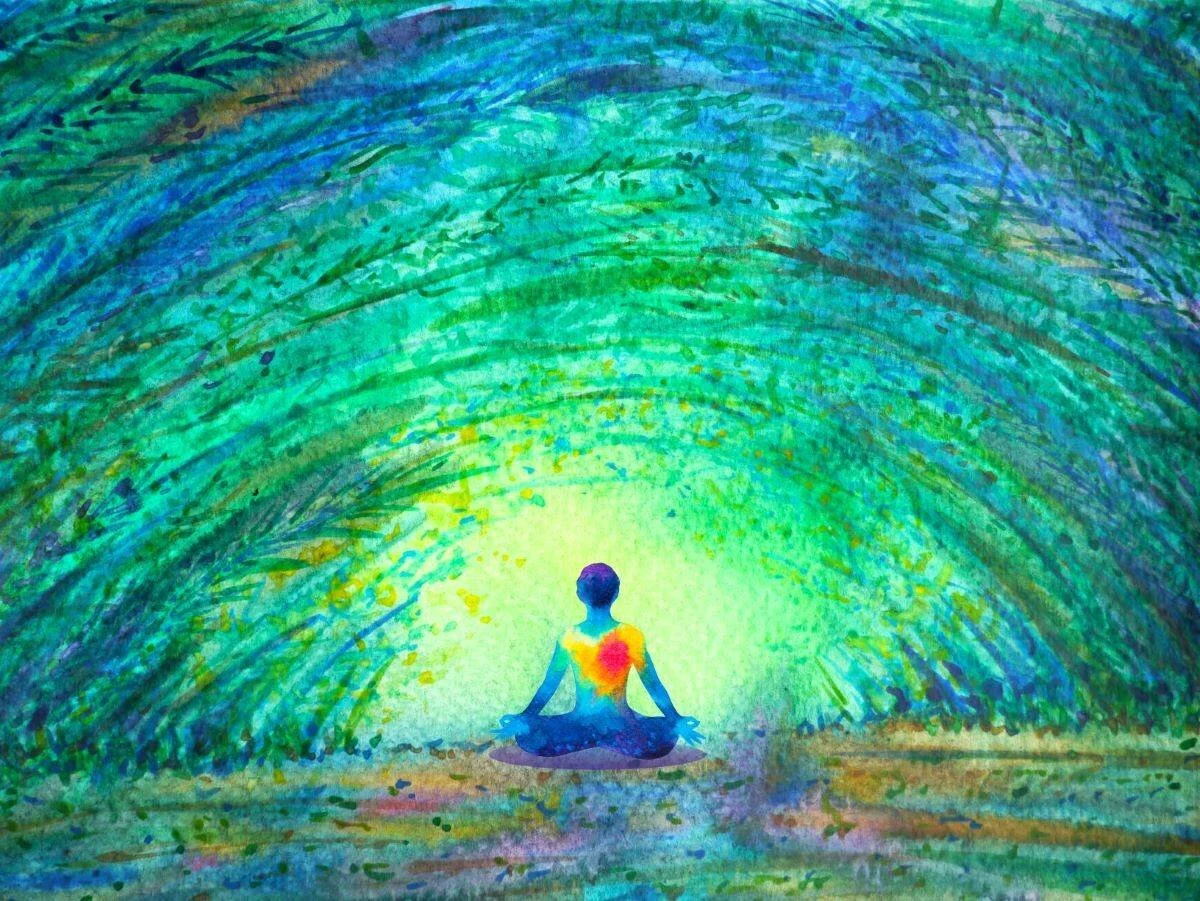“The real translation is when the words jump off the page into your senses, into your body, and light up your heart. The translation continues when you are able to engage with your yoga or meditation or mindfulness practice with a bit more love and liveliness.”
There are 112 yogas, called yuktis in the text, and each one is described in 32 syllables. The composers loved long compounds such as samatvavijñānasamudgamanabhājanam and padmasampuṭamadhyagaḥ. When these long compounds are dissolved, there are generally eight to thirteen words. Each word may have a meaning in meditation, and also in music, dance, astrology, astronomy, alchemy, sex, prayers, and something to do with horses. The full glossary entry for the eight or so words used in a sutra generally runs to over a thousand words. This manuscript (the Radiance Sutras) is over 149,000 words, and is only a fraction of the notes I have made over the past 25 years of letting the Sanskrit sing itself into English.
With such rich polysemy, hundreds of very different translations could be done. This is intentional. The Sanskrit of the text is constructed so that you could translate it afresh every day for a lifetime and continue to see new meaning. I often do thirty to forty different translations and let the text sing itself into something lively. This often takes several months in which I am doing nothing except chanting the Sanskrit of this brief text all day, from 4 in the morning until dawn, and then for several more hours before noon, and again in the afternoon. I ask the Sanskrit of the text to repeat itself like a prayer of the heart, and I listen to the pulsation and the music of it. I am usually standing, subtly dancing, and walking around while doing this –– you can only go so far with a text like this if you are sitting at a desk.
The real translation is when the words jump off the page onto your tongue and light up your eyes and your heart. And the translation continues when you are able to engage with your yoga practice with a bit more love and liveliness.
In this tradition, we don’t impose the teachings and techniques — we discover them already here.
I have been delighting in the 112 yogas (yuktis) presented in this text for the past 52 years, and in teaching, I use this text daily. I find that even beginners recognize themselves in the yuktis, “I know that one! That is my favorite secret way of coming home to myself!”
We do not so much reconstruct the text in our lives as access the intelligent life energy-wisdom the text emerged from. In this tradition, we don’t impose the teachings and techniques — we discover them already here.
Translation is a joyous process of discovery, of realization entering new levels and new bodies, and the original text is rediscovered - is brought alive - as new listeners engage with the text. Many kinds of translation can be done, depending on the purpose. There are scholarly translations, which use the tools of historical criticism to create versions of the text appropriate for publication in a scholarly journal. This is a translation into the vernacular, using the metaphoric richness of Sanskrit.
When you read, you are translating the words of the text into your living experience. You may be a beginner or not even a beginner, at 112 of these practices. But you are a master, an adept at one. Discover that one. Enter there. And continue the exploration. You may be great at taking naps, having sex, rocking out to music, working yourself to exhaustion, hanging out with dogs, riding horses, or being addicted to things. Recognize the path you know and start to expand from there. Explore.
Above all, be friendly to yourself. Shiva is “gracious, favorable, benign, kind, benevolent, friendly, dear, happy.” (Monier-Williams, p. 1074). Treat yourself with graciousness and hospitality. You are not alone. No matter how much you want to learn to meditate, your soul wants you even more.
We are perfectly designed to enter the mystery.
Polysemy (diversity of meanings) in Sanskrit
“There are in every language polysemic words for which there are no English equivalents, words that have not a single meaning but a range of meanings, and Sanskrit is particularly prone to this semantic proliferation: it has been said that every word in Sanskrit designates its basic meaning, the opposite of that, a word for an elephant, a name of God, and a position in sexual intercourse. In confronting a Sanskrit text, therefore, the translator must make choices that reflect his or her opinion of what the text is most likely to be about (an elephant, God, …)”
Padma - flower of the lotus-plant which closes toward evening. The form or figure of a lotus. A name given by the tantrikas to the 6 divisions of the upper part of the body called cakras. Red or colored marks on the face or trunk of an elephant. A particular part of a column or pillar. A kind of temple. An army arrayed in the form of a lotus. A particular posture of the body in religious meditation. A kind of coitus. One of the 9 treasures of Kubera. A particularly high number (1000 millions or billions.) (more).
As eccentric and wacky as all these diverse meanings may seem, they give visceral clues to meditators who are in the midst of experience. When taken as metaphor, they suggest nuances of experience. A book or dissertation could be written about each word in this text, and sometimes about each syllable.
Māyā - measuring. Creating illusions (said of Vishnu). art, wisdom, extraordinary or supernatural power (only in the earlier language). Illusion, unreality, deception, fraud, trick, sorcery, witchcraft magic RV. An unreal or illusory image, phantom, apparition. Duplicity (with Buddhists one of the 24 minor evil passions). (in phil.) Illusion (identified in the sāṃkhya with prakṛti or pradhāna and in that system, as well as in the vedānta , regarded as the source of the visible universe). (with śaivas) one of the 4 pāśas or snares which entangle the soul.(with vaiṣṇavas) one of the 9 śaktis or energies of viṣṇu. Illusion personified (sometimes identified with durgā, sometimes regarded as a daughter of anṛta and nirṛti or nikṛtiand mother of mṛtyu, or as a daughter of adharma). Compassion, sympathy. Name of the mother of Gautama Buddha. Name of Lakshmi. of 2 metres.
The definition of a Sanskrit word is often like an impressionistic poem. Saturated with myth and multiple meanings.
Let's look at bhāvanā.
• causing to be , effecting , producing , displaying , manifesting. promoting or effecting any one's (gen. or comp.) welfare.
• imagining , fancying. teaching. m. a creator , producer , efficient MBh. m. N. of śiva. m. of viṣṇu
• m. of the 22nd kalpa (q.v.).
• n. the act of producing or effecting. (ā)n. forming in the mind , conception , apprehension , imagination , supposition , fancy , thought , meditation (°nayā ind. in thought , in imagination ; °nām- √bandh , with loc. , to occupy one's imagination with , direct one's thoughts to).
• n. (in logic) that cause of memory which arises from direct perception.
• n. application of perfumes.
• f. demonstration , argument , ascertainment.
• f. feeling of devotion , faith in (loc.)
• f. reflection , contemplation (5 kinds with Buddhists)
• f. saturating any powder with fluid, steeping, infusion.
• f. (in arithm.) finding by combination or composition.
• f. (with jainas) right conception or notion
• f. the moral of a fable.
• f. N. of an upaniṣad
• n. (ifc.) nature , essence.
In bhāvanā there is the general, abstract notion of producing, displaying, and welfare. Then slightly more specific, imagining, a creator. Forming in the mind. Meditation. Then in logic, memory that comes from direct perception. In grooming, the application of perfumes. In argument, demonstration. In religion, a feeling of devotion. Five kinds of contemplation. In making tea, tinctures, herbs, the process of saturating a powder with fluid. In arithmetic, something about composition. In storytelling, the moral of a fable. And then there is bhu:
bhu- to become, be, arise, come into being, exist, be found, live, stay, abide, happen, occur. To cherish, foster, animate, enliven, refresh, encourage, promote, further. To addict or devote oneself to, practice. To subdue, control. To manifest, exhibit, show, betray. Becoming, being, existing, springing, arising. The place of being, space, world, or universe. The earth, ground. Soil. Floor. Pavement. A spot or piece of ground.
I generally use the Monier-Williams, with occasional corrections or enhancements from Lakshmanjoo and Jaideva Singh. But there are additional layers of polysemy in the words, which are not dictionary-based. For example, “Vijnana is a technical term here meaning the name of the mantras and their structure.” - p. 151. Abhinavagupta: Para-trisika-Vivarana, The Secret of Tantric Mysticism, by Jaideva Singh. Motilal Banarsidass, Delhi, India, 2014. We each have a different dictionary in our heads, a different series of associations and different willingness to go where the language is suggesting we go, which is into the total lusciousness and spontaneity of the life impulse.
The real translation is always happening now, as we enter the conversation between Consciousness and Life, spirit and matter, form and emptiness.










